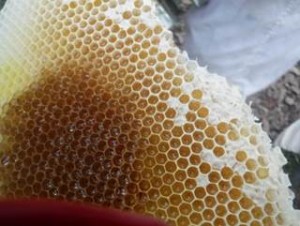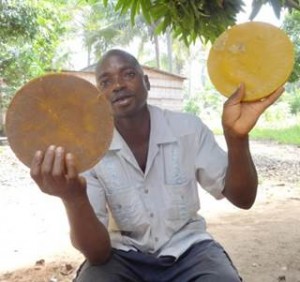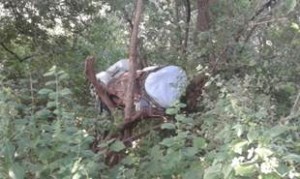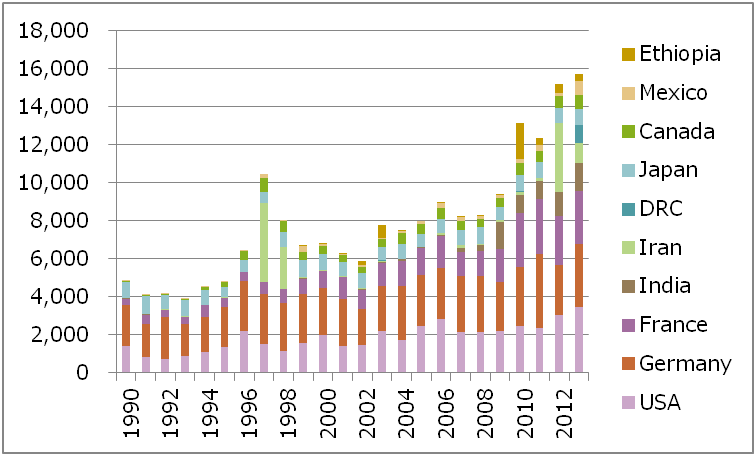Beeswax

A nest (or a “comb”, as it is called in beekeeping) is filled with honey. A nest from which honey has been removed, which has then been heated in water and shaped, is called beeswax.

Beeswax is purified by being heated in hot water. Beeswax after the primary purification (left) and after the secondary purification (right) (Mozambique).

A traditional beehive in Africa that uses a tree trunk (Senegal). Honeybees in Africa are aggressive and caution is required in approaching beehives.
Source plants
- scientific name
- Apis mellifera adansonii and A. m. scutellata
- general name
- Honeybees found in Africa
- overview
-
Nine species of the genus Apis spp. have been confirmed: A. mellifera, A. serana, A. dorsata, A. laboriosa, A. florae, A. andreniformis, A. koschevnikovi, A. nigrocincta, and A. nuluensis. Honeybees are distributed in Europe, Africa, and Asia, with at least 28 subspecies confirmed so far. Eleven subspecies are known to originate from Africa, including A. m. adansonii (found in countries around the Gulf of Guinea in West Africa, including Senegal, Burkina Faso, Nigeria, Cameroon, and Gabon) and A. m. scutellata (found in East Africa and South Africa). Hybrids between A. m. scutellata and European A. m. ligustica or A. m. iberiensis are called Africanized bees and are used in beekeeping in South Arica. African bees A. m. adansonii and A. m. scutellata are very aggressive, with superior defense and survival instincts. African countries have not traditionally practiced beekeeping and have collected honey from natural nests; therefore, bee breeding has not been done. While beekeeping has recently started in Africa, use of these aggressive bees has resulted in many deaths of beekeepers and the necessity of good protective clothing is more important in Africa than in Japan.
Product characteristics
- use
- Beeswax is used as a coating agent in the following products: Cosmetics (cream, lipsticks, eye shadow), food (baking sheet oil, mold lubricant for Japanese and western cakes), ointments, printing ink, CDs, and hides.
- area
- African countries that produce honey (top three beeswax-producing African countries are Ethiopia, Angola, and Kenya [FAOSTAT])
- overview
-
Beeswax is a natural wax secreted by honey bees from the wax-producing abdominal glands on their sternites. Humans obtain beeswax by heating and melting bee nests. Beeswax contains wax esters as the major components, is relatively soft, and has plastic properties. Beeswax is used as a coating agent in various everyday products, as well as in candles and crayons. Most beeswax used in Japan is imported after going through two or three purification processes in the producing countries. Beeswax companies in Japan carry out the final purification, using a special machine to remove scents and colors before selling it to cosmetics and pharmaceutical companies as pellets. Currently, it is difficult to substitute beeswax with synthetics and thus we can continue to expect a certain level of demand.
African bees (A. mellifera spp.) drawing attention
African countries primarily export beeswax derived from A. m. adansonii. Beeswax derived from A. m. adansonii is very close to other beeswax produced in Africa and Europe (derived from A. mellifera spp.). On the other hand, it has been reported that the beeswax derived from A. m. adansonii has a chemical composition very different from the ones derived from Asian bees (A. dorsata, A. florae, and A. cerana indica). Specifically, the beeswax derived from African bees contains less of the C25 compound and more of the C31 and C33 compounds, compared with the beeswax derived from Asian bees. Also, the monoester composition of beeswax is simpler in Asian bees than in European and African bees: C40 compound in A. dorsata; C40 and C46 compounds in A. cerana; and C44, C46, and C48 compounds in A. fiorea are the major components. Also, the beeswax derived from A. dorsata is different from the beeswax derived from European and African bees in that the former contains C40–C46 hydroxymonoesters and the latter contains little of these. Furthermore, compared with the beeswax derived from European and African bees, the beeswax derived from Asian bees, especially A. dorsata, has an much fewer long-chain hydrocarbon compounds, which is believed to be the reason why it contains less hydrocarbon content. Monoester content is lower and monoester composition is simpler in beeswax derived from Asian bees, suggesting that the beeswax derived from Asian bees contains more diester, polyester, and hydroxyester. As the free fatty acid content of the beeswax derived from Asian bees is lower than what its low acid value predicts, it is estimated that beeswax derived from bees other than African bees contain more fatty acid esters. Based on these results, the beeswax derived from Asian bees is softer, compared with the beeswax derived from European and African bees. In this way, analytical results are clearly different between the beeswax derived from Asian bees and the beeswax derived from European and African bees. Thus, the former cannot substitute the latter.
Also, African beeswax has not only a unique chemical structure but also a low possibility of containing impurities, such as pesticides and hormones, as extensive farming and beekeeping are not commonly practiced in Africa.
Export and import trends, demands in Japan
Japan is the seventh largest importer of beeswax in the world (700–900 t/year). While the volume of beeswax imported by Japan has been stable (858 t/year in 1900 and 803 t/year in 2013), the world imports have increased over two-fold since 1900 (Fig. 1). On the other hand, the world’s production of beeswax has been stable (Fig. 2), resulting in the import unit price of beeswax jumping more than two-fold from 469 yen/kg in 2011 to 1,096 yen/kg in 2015. Currently, Japan imports beeswax mainly from Vietnam, Tanzania, and Ethiopia. The trends between 2011 and 2015 tell us that the imports from Vietnam and Ethiopia are increasing, and the import from Tanzania is decreasing.

Fig. 1 Changes in import amount (t) from top 10 import source countries (Source: FAO)

Fig. 2 Changes in production (t) in top 10 producing countries (Source: FAO)
Market prospects
In recent years, Japan’s import of beeswax from Tanzania has been decreasing, whereas the country’s overall beeswax import has been stable. It is suggested that part of the Tanzania-made beeswax that Japan used to import has been substituted by the beeswax produced in Ethiopia and Vietnam. African-made beeswax has unique properties that Asian-made beeswax does not have and is expected to continue to enjoy a certain level of demand. Also, in Vietnam, which has achieved remarkable economic growth in recent years, the purchase price, thus sales price, of beeswax from producers may increase. France, which imports beeswax primarily from African countries, has seen a gradual increase in beeswax imports. Based on these trends, it is possible that demand for beeswax produced in African countries, other than Tanzania and Ethiopia, will increase in the future. While honey is a valuable source of income for the poor in Africa, and is already distributed in the domestic and international markets, it is likely that beeswax has been discarded by them. According to FAO statistics, the ratio of beeswax production to honey production is lower than 0.05 in many countries (Table 1). There are several possible reasons: the market value of beeswax is simply not recognized or, even if it is recognized, producers do not know how to contact potential purchasers or how to process beeswax.
Table 1 Honey and beeswax production and other statistics in major honey- and beeswax-producing countries in Africa (Data: FAOSTAT) production in 2014(t) honey/beeswax forests GDP($) honey beeswax are
(1,000ha)proportion(%) 1 Ethiopia 45,000 4,042 0.090 12,296 11 687 2 Tanzania 30,000 1,760 0.059 33,428 38 957 3 Angola 23,300 2,266 0.097 58,480 47 3,876 4 Kenya 12,00 2,468 0.206 3,467 6 1,434 5 Algeria 6,147 – – 1,492 1 4,174 6 Morocco 5,300 180 0.034 5,131 11 3,002 7 Egypt 5,100 131 0.026 70 – 3,710 8 Tunisia 5,100 61 0.012 1,006 6 3,923 9 Madagascar 4,400 394 0.090 12,553 22 402 10 Cameroon 4,300 288 0.067 19,916 42 1,235 11 Senegal 3,150 156 0.050 8,473 44 913 However, to ensure stable beeswax production in Africa, where beekeeping has not traditionally been practiced, many challenges need to be overcome. Collection of honey and beeswax from natural nests, not beehives, sometimes involves the use of fire for keeping away aggressive bees, which can result in bushfires and forest reduction. Deforestation means no bee plants, and forest reduction will affect honey and beeswax production. Instead of purchasing beeswax derived from wild nests, businesses should only purchase beeswax derived from captive beehives, promote beekeeping by increasing the local people’s incentives for taking up the beeswax business, and prevent bushfire. However, there have been many cases where beehives were supplied to the local people as part of official development assistance (ODA) programs and NGO projects to promote honey production, but beekeeping did not gain popularity there. You cannot simply leave beehives in a forest and expect to produce sufficient amounts of honey and beeswax. In the future, it is expected that beehives suitable for local environments be supplied, beekeeping techniques be taught, and honey and beeswax marketing and distribution systems be established.
- references
-
- Tulloch A.P. 1980: Beewax–Composition and Analysis, Bee World, 61:2, 47-62
- Waś E., T. Szczęsna, H. R. Chmielewska 2014: Hydrocarbon composition of beeswax (Apis Mellifira) collected from light and dark colored combs, J. Apis Sci., 58:2, 99-106
- https://en.wikipedia.org/wiki/Beeswax
- FAOSTAT


